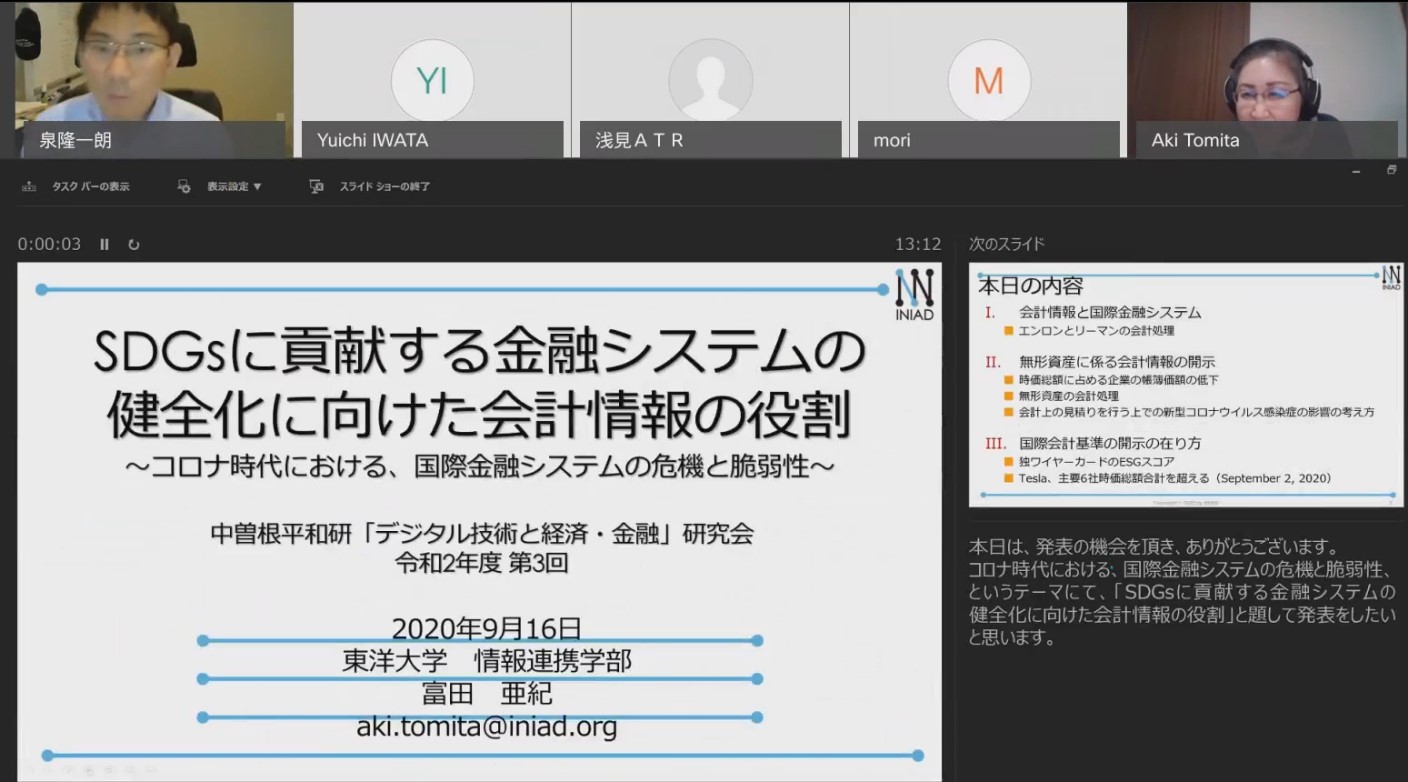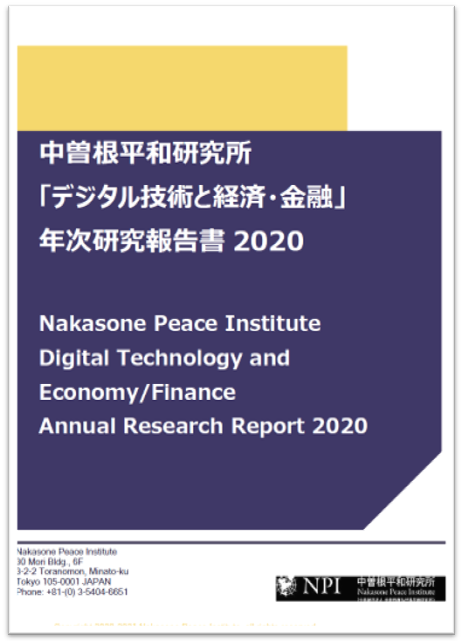2020/09/28
" The Crisis and Vulnerability of the International Financial System in the COVID-19 Era " ("Digital Technology and Economy/Finance" Study Group)
The Nakasone Peace Institute held the web conference on "The Crisis and Vulnerability of the International Financial System in the COVID-19 Era" with Dr. Aki Tomita (Professor, Department of Information Networking for Innovation and Design, Toyo University) , Dr. Ryuichiro Izumi (Assistant Professor of Economics, Wesleyan University), and other regular members, on September 16th 2020.
1 Presentation " The role of accounting information in contributing to the healthier financial system for the SDGs " (Dr. Tomita)
■The Global Financial and Economic System and Accounting Information: Enron, Lehman and ESG Investment
The first example that comes to mind of a disruption in the financial system that was triggered by accounting information is the collapse of Enron Corp. in the United States in 2001.
The company developed derivatives for long-term natural gas futures trading and set up a website called Enron Online. Furthermore, the company "transferred" losses from those transactions to special purpose entities (SPEs), which were difficult to determine whether or not they were consolidated as subsidiaries under the rules of the time. As a result of restatement of the financial statements of the company for previous years, it was revealed that its financial condition was worse than expected, and it led to its bankruptcy.
This incident led to the enactment of the Sarbanes-Oxley Act in 2002 as part of efforts to strengthen corporate governance in order to restore investor confidence in financial markets, a move that has since spread to Japan and the rest of the world.
When Lehman Brothers went bankrupt in 2008, the company needed to raise its net leverage ratio (net assets to tangible equity) to maintain its credit rating, which is a lifeline for fundraising, as the financial crisis deepened. Lehman took assets temporarily off the balance sheet before the end of the reporting periods to reduce its reported net leverage and did not disclose the use of special accounting devices. This accounting treatment itself was permitted by the US accounting standards, but it was considered as a problem because of the misleading financial statement disclosure to investors.
Around the same time, in 2006, the United Nations declared the Principles for Responsible Investment (PRI), which emphasized the link between investment and ESG (Environmental, Social and Governance) global issues. Currently, the PRI focuses on climate change measures and the realization of the Sustainable Development Goals (SDGs), through 2027. In this context, financial statement disclosures, especially those that lead to a healthier financial system and improvements in financial disclosure, are becoming more important in order to further diversify funding sources, including for social entrepreneurs.
■The issues surrounding the disclosure of accounting information on intangible assets - in light of the growth in intangible asset-like value that significantly exceeds the net asset value
The "total net assets/total market capitalization" of all U.S. equity index S&P 500 companies has fallen from 83% in 1975 to 16% in 2015. That's how much value is reflected in the value of the stock that is not reflected in the book value on the financial statements.
As a concrete example, much of the value of data held in GAFA, research and development assets, and other assets are not on the balance sheet. This is because there are no clear accounting rules for these values on the balance sheet. In order to develop these rules, there needs to be a (international) rules agreement on the estimation of how these will create wealth in the future.
■How the disclosure of International Financial Reporting Standards should be done to contribute to the soundness of the financial system - toward integration of trust in companies and their growth potential with the current financial statement disclosure and third-party evaluation
In June of this year, Wirecard, a German-based financial services company, went bankrupt. In fact, the company's ESG score from several rating agencies was not low, and this was one of the cases that cast doubt on the perception that ESG investing is a way to avoid the risk of losses due to some scandals in the investments.
Also, the electric car maker Tesla, a highly recognized ESG stock, has seen its market capitalization expand dramatically in recently, surpassing the combined market capitalization of all six major automakers, including Toyota. Tesla's valuation includes the expectation that it could revolutionize the industrial structure, but it is not clear, even when comparing its main financial items with those of Toyota Motor, how Tesla's market capitalization is so high.
In light of these circumstances, I would like to propose that items that can add credibility to the disclosure of International Financial Reporting Standards (IFRS) should be proactively incorporated into the mandatory disclosure to make the information more useful for investors' decision-making.
2 Presentation " The Financial market stagnation and international cooperation, with a focus on securitized products " (Dr. Izumi)
■What is "Securitization"? -Its History and Development
"Securitization" stands for "the creation of new securities or financial instruments from assets". It can be seen as a process that goes beyond the simple function of lending and borrowing money, by collecting the "assets of debt" and issuing securities backed by the future cash flows that these assets will generate.
The history of securitization began in 1968 with the mortgage-backed securities (MBS). The Federal Home Mortgage Corporation (Fannie Mae) and the Federal Home Loan Mortgage Corporation (Freddie Mac) were established to promote home ownership among the American people, and the securitization was used to control lending rates. In the 1980s, securitization products backed by a broader range of credits began to emerge. The market continued to expand in the 1990s and 2000s amid intensifying competition due to monetary easing and a moral hazard of sorts, with borrowers who were known to be in danger of creating loan facilities.
Then, from 2007 to 2008, a financial crisis was triggered by the fall in housing market prices. The point at this time was that although the decline in housing prices itself began in 2006, it took time to assess the value of individual loan assets and to estimate the impact of losses on securitized products.
After the crisis, various regulations were introduced to increase transparency. The Dodd-Frank Act required more detailed disclosure of the loan pools (aggregates) underpinning securitizations and also required their originators to hold a certain percentage of credit risk. These measures led to a decline in issuance in the securitization market, but it is now recovering again.
What is the outlook for securitization markets in major countries other than the US? In the UK and Europe, like the US, securitization markets were growing before the financial crisis, but have been slow to recover after the crisis.
China began pilot operations in 2005, but temporarily suspended them in 2009 in response to the global financial crisis. It resumed operations from 2012 onwards, and in 2017 alone exceeded Japan's issuance volume. However, the challenges are that the related legal base is weak, the tax system is not well-developed, and liquidity (trading volume) in the secondary market is very low.
Compared to Europe and the United States, Japan's market is far smaller. The Cabinet Office of Japan points out, as the reasons, that the real estate asset market is stagnant, and securitization does not make it an attractive asset.
■Benefits and Costs of Securitized Products
While the probability of repayment of individual loans varies widely, the securitization of a combination of these loans has the following four advantages: (1) Easier to manage risk; (2) Easier to create loan asset products that meet the investment needs of investors; (3)Easier to secure liquidity for the underlying creditor; and (4) Easier for the borrower to control interest rates (funding costs).
On the other hand, there are disadvantages (costs) brought about by the complexity, lack of transparency, and distorted incentives that became even more apparent before and after the financial crisis, and how to balance these disadvantages (trade-offs) is one of the key points for further utilization of securitization.
■International Policy Discussion and Coordination on Securitized Products
Since the London Summit in 2009, following the financial crisis, the Basel Committee on Banking Supervision and national authorities have been discussing ways to improve securitization rules. The International Organization of Securities Commissions (IOSCO) has also published a basic code of conduct for credit rating agencies, which is expected to improve the differences and complexities of regulatory systems across countries. I feel that if the sharing of databases on securitized products among the authorities of major countries is promoted in the future, it would be good in terms of reducing information asymmetry.
The novel coronavirus has had a negative impact on the securitization market as well, in terms of lower issuance volume and higher financial costs. In March, the Federal Reserve announced a time-limited program through December to accept collateral for some highly rated securitized products and provide loans for three years. This program is intended to support the securitization market.
3 Discussion
■Main issue 1: New Strategies of Countries for Financial Technology, Financial Markets and Financial Rules in the COVID-19 Era
○With regard to the direction of China. One possible strategic direction could be to increase the liquidity of the securitized products and other financial instruments distribution (trading) market, to attract foreign investors, and to increase the number of domestic investors.
Also, in the case of China, pilot projects are often carried out (e.g., the digital Chinese yuan). There may be trials to see how digital technology can be used in the development of securitized products and other financial product markets. The country has a much more flexible risk-taking approach than other countries.
○In addition, we should not miss the growing use of social networking services (SNS) in each country to evaluate financial products and investment targets. In some sectors, social networking services may play an alternative role to valuation agencies.
○In the US, despite the impact of the new coronavirus, the rules and products have been better analyzed than at the time of the financial crisis, and the market itself remains largely intact, backed by the depth of its original investor and issuer base. Therefore, there may not be a major change in the rules surrounding securitization and other financial products.
Also, as symbolized by the rise in Tesla's market capitalization, investors in the NASDAQ and other U.S. stock markets, where startups go public, tend to highly evaluate the future growth potential of high-tech and ESG-related companies as changing the industrial structure of the world.
■Main issue 2: Future Global Frontiers in Financial Instruments and Accounting Disclosures
○Efforts to develop a system for the disclosure of intellectual property, including data, are being made worldwide. The challenge is how to show the linkage between the intellectual property owned by a company and its value and the value creation process.
(At the discussion with the American Accounting Association, it was suggested that international accounting standards that require capitalization of development costs that meet certain requirements might be more appropriate.)
○Regarding the use of financial instruments, including securitized products, for global risk management: For local crises, such as natural disasters, financial instruments such as securitized products can be structured based on the weak linkage and correlation between the risks. For example, if a natural disaster occurs in California, it will be safe in Massachusetts, or vice versa, and can be placed in a single credit pool as "risk diversifiable". In this way, financial instruments can be effective from a risk-sharing perspective.
On the other hand, for economic crises that occur to some extent on a large global scale, there are still challenges in demonstrating resilience as a securitized product.
■Main issue 3: International Opportunities for Japan
○Efforts to increase the liquidity of securitization and other financial products in the secondary market, including securitization, by improving methods of disclosing information on individual products and creating products that make use of knowledge in regional and specialized fields, are important for improving Japan's status in the international financial markets while broadening and deepening the range of investors and issuers, including foreign investors.
(In order to overcome the cautious attitude of Japanese investors and the difficulty in creating "profitable products"...)
○In addition, the initiatives about financial products such as securitized products could play a leading role with the idea of indexing the " non-transparency" of individual products in order to curb the mechanism that could amplify shocks in a crisis.
○The International Integrated Reporting Council (IIRC) is leading efforts to create a unified international evaluation index for ESG (environmental, social, and governance) management in support of the United Nations initiative, the Sustainable Growth Goals (SDGs). There is room for Japan to make a contribution in these areas.






